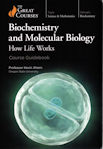This is the course guidebook that accompanies the 36 lecture “Great Course” of the same name. It is essentially an abbreviated transcript of each lecture, some related reading, and some questions. (I watched the lectures, which is what I am reviewing here, and am using the book simply as an aide-memoire.)
This is fascinating. The first 24 lectures are on biochemistry: all the complex molecules and reaction pathways in living cells, that break down inputs, build up the molecules we need, along with producing and consuming chemical energy. On the one hand, there is a pile of unmemorable and complicated names. On the other hand, the diagrams show that the molecules in the pathways typically change just an atom or two, or a small group, at a time. This shows both the incremental nature of many of the pathways, and how nevertheless a small change can have a large effect. All the various processes are carefully regulated by other processes, and everything interacts. Nasty diseases occur when things go wrong.
The final 12 lectures are on molecular biology: the chemistry of DNA, RNA and protein manufacture. This is even more complicated – the description of DNA replication is mind-blowing: the two strands are copied using completely different mechanisms because one of them has to be copied “backwards” – and everything has a bit more wiggle room. For example, I discovered that some of the tRNAs that translate from RNA triplets to protein amino acids have a “wobbly base” that isn’t one of the four standard RNA bases. Regulation of protein expression can happen in many places at many levels: the DNA is wound up and needs to be unravelled for the genes to be accessed for transcription; transcription factors (themselves proteins) promote and repress transcription; operons (clusters of related genes) are controlled together by a single promoter; different subsets of exons are expressed in different places and times as the “naive” mRNA is spliced to form the “mature” mRNA; mRNAs are degraded; and mature mRNA translation can be block. I expect there are more!
And these processes are fast, and expensive. To power it all, we manufacture our own body-weight of the energy molecule ATP every day, and degrade it again, in a ceaseless cycle.
I won’t remember all the chemical names (or the songs…). It did help having some background from a previous course on organic chemistry. What I will remember is the amazing complexity built from relative simplicity.
